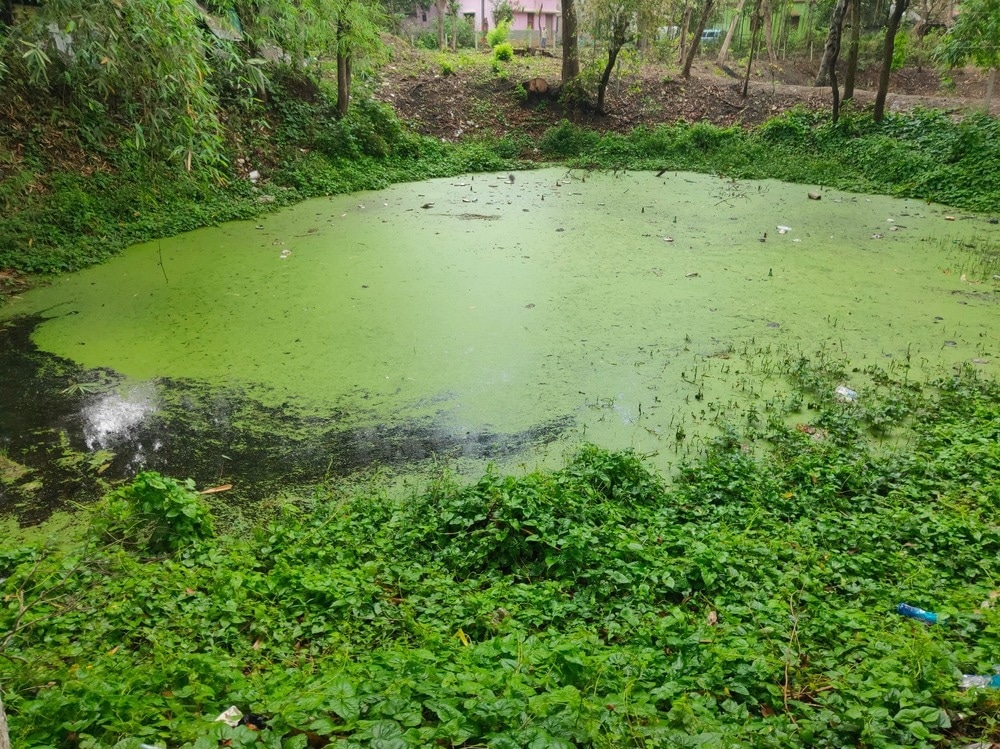In a recent article published in Nanomaterials, researchers from China introduced a novel adsorbent material, Sodium Alginate/UiO-66-NH2 nanocomposite, for efficient phosphate removal from aqueous solutions.

Image Credit: Manishankar Patra/Shutterstock.com
This research addresses phosphorus pollution, a significant environmental concern causing eutrophication, by exploring the potential of modified metal-organic framework materials for effective phosphate adsorption.
Background
Phosphorus pollution in water bodies has become a critical environmental issue due to its harmful effects on aquatic ecosystems and human health. Excessive phosphate levels lead to eutrophication, algal blooms, and oxygen depletion, disrupting aquatic ecosystems.
Traditional methods for phosphate removal, such as chemical precipitation and biological treatment, are limited in efficiency, cost-effectiveness, and environmental impact. Hence, advanced materials and technologies are needed for effective phosphate remediation in wastewater treatment.
The Current Study
UiO-66-NH2 nanoparticles were synthesized using zirconium oxychloride octahydrate. The synthesis involved reacting zirconium chloride with ammonium molybdate and potassium antimony tartrate hemihydrate in the presence of sodium hydroxide. The resulting nanoparticles were characterized using scanning electron microscopy (SEM) and X-ray diffraction (XRD) analysis for size, morphology, and chemical composition.
The composite material was analyzed with SEM to investigate the morphology and structure of the hydrogel beads, Fourier transform infrared spectroscopy (FTIR) to identify chemical composition and functional groups, and XRD for crystalline structure. Nitrogen adsorption-desorption measurements determined the surface area and porosity of the material.
Batch adsorption experiments evaluated the phosphate removal efficiency of the composite material, examining the effects of pH, temperature, adsorbent dosage, and initial phosphate concentration. Dynamic adsorption studies using a fixed-bed column setup assessed the material's adsorption capacity under continuous flow conditions.
The composite material's cyclic adsorption performance was evaluated through regeneration and reusability testing. The material was subjected to multiple adsorption-desorption cycles to assess its stability and efficiency over time. The regeneration process involved washing and reactivation steps to restore the material's adsorption capacity for subsequent use.
Results and Discussion
SEM analysis revealed the uniform distribution of UiO-66-NH2 nanoparticles within the sodium alginate matrix, confirming the successful synthesis of the composite hydrogel. Surface modification with polyethyleneimine and Zr4+ ions was evident from changes in the morphology and surface features.
FTIR confirmed the presence of functional groups associated with sodium alginate, polyethyleneimine, and UiO-66-NH2. XRD showed characteristic peaks of UiO-66-NH2, indicating their retention within the hydrogel matrix.
Batch adsorption experiments demonstrated high phosphate removal efficiency under varying pH and temperature conditions, with optimal adsorption at pH 2. The temperature-dependent adsorption indicated an endothermic process, favoring higher temperatures. The adsorption isotherm data fitted well with the Freundlich model, suggesting multilayer adsorption with heterogeneous surface interactions between the adsorbate and adsorbent.
Dynamic adsorption studies using a fixed-bed column setup showed the composite material's continuous phosphate removal capability under varying flow rates and initial phosphate concentrations. The breakthrough curves indicated efficient phosphate ion removal from aqueous solutions. The adsorption capacity remained stable over extended continuous flow periods, highlighting its potential for practical water treatment applications.
Cyclic adsorption tests demonstrated the excellent reusability and regeneration capability of the composite material. After multiple adsorption-desorption cycles, the material maintained a high adsorption rate of 99 %, indicating its robustness and stability over repeated use. The regeneration process effectively restored adsorption capacity, making it a sustainable and cost-effective solution for phosphate removal from wastewater.
Conclusion
The study developed a Sodium Alginate/UiO-66-NH2 nanocomposite with promising adsorption capabilities for phosphate removal. The research highlights the potential of modified metal-organic framework materials in addressing phosphorus pollution in aquatic environments.
The findings suggest that the composite material could be a valuable solution for efficient phosphate remediation, contributing to environmental sustainability and improved water quality.
Journal Reference
Lin X., et al. (2024). Sodium Alginate/UiO-66-NH2 Nanocomposite for Phosphate Removal. Nanomaterials. DOI: 10.3390/nano1414117